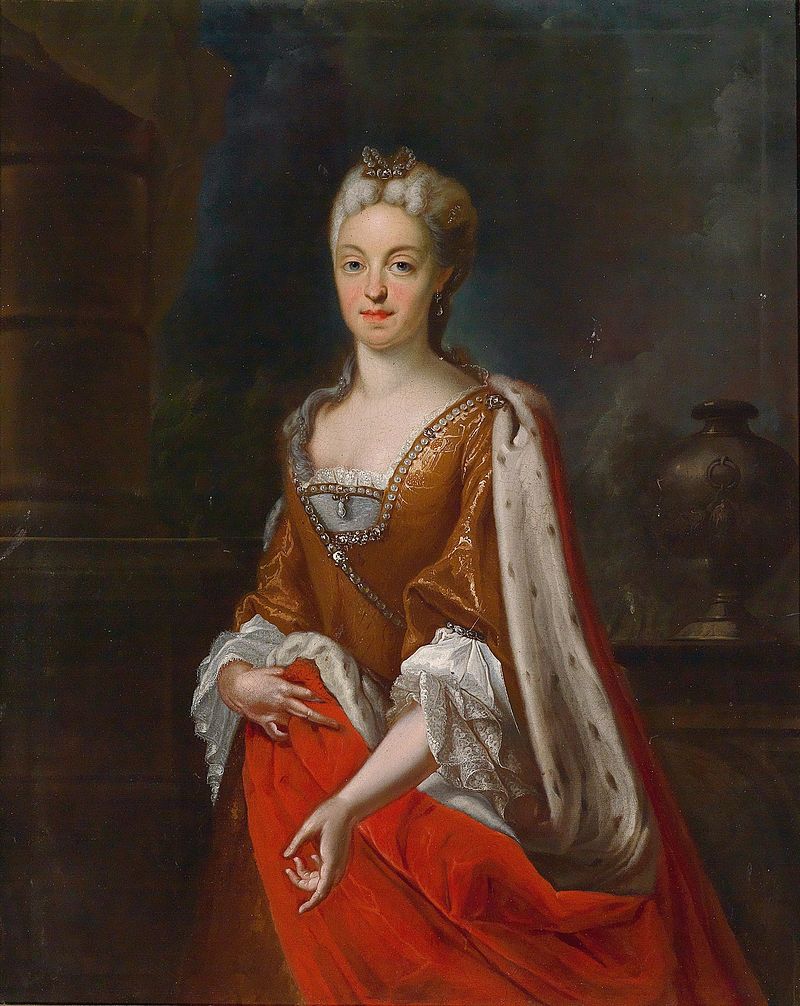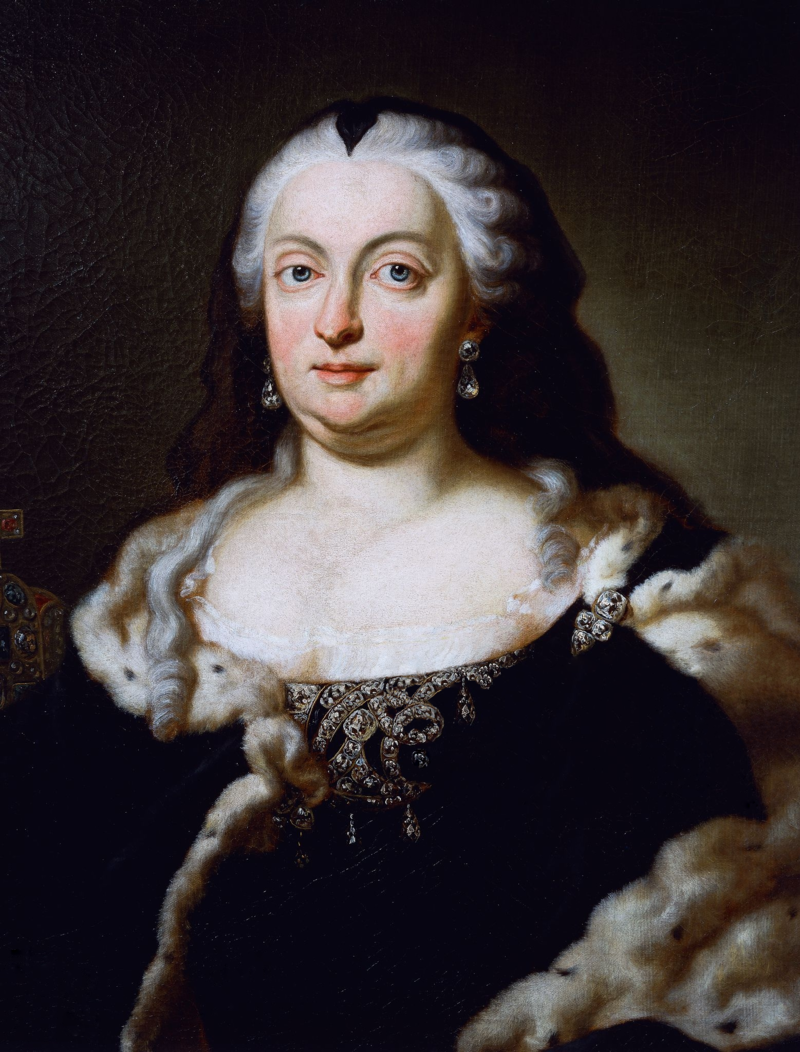by Susan Flantzer
© Unofficial Royalty 2023

Maria Amalie of Austria, Holy Roman Empress; Credit – Wikipedia
The Holy Roman Empire was a limited elective monarchy composed of hundreds of kingdoms, principalities, duchies, counties, prince-bishoprics, and Free Imperial Cities in central Europe. The Holy Roman Empire was not really holy since, after Holy Roman Emperor Charles V in 1530, no emperors were crowned by the pope or a bishop. It was not Roman but rather German because it was mainly in the regions of present-day Germany and Austria. It was an empire in name only – the territories it covered were mostly independent each with its own rulers. The Holy Roman Emperor directly ruled over only his family territories, and could not issue decrees and rule autonomously over the Holy Roman Empire. A Holy Roman Emperor was only as strong as his army and alliances, including marriage alliances, made him, and his power was severely restricted by the many sovereigns of the constituent monarchies of the Holy Roman Empire. From the 13th century, prince-electors, or electors for short, elected the Holy Roman Emperor from among the sovereigns of the constituent states.
Frequently but not always, it was common practice to elect the deceased Holy Roman Emperor’s heir. The Holy Roman Empire was an elective monarchy. No person had a legal right to the succession simply because he was related to the current Holy Roman Emperor. However, the Holy Roman Emperor could and often did, while still alive, have a relative (usually a son) elected to succeed him after his death. This elected heir apparent used the title King of the Romans.
- Learn more at Unofficial Royalty: What was the Holy Roman Empire?
********************
Archduchess Maria Amalie of Austria was the wife of Karl VII, Holy Roman Emperor who was also Karl I, Elector of Bavaria. Born on October 22, 1701, at Hofburg Palace in Vienna, Austria, Maria Amalie was the youngest of the three children and the second of the two daughters of Joseph I, Holy Roman Emperor, King of Bohemia, Archduke of Austria, King of Croatia, King of Hungary and Princess Wilhelmine Amalie of Brunswick-Lüneburg. Her paternal grandparents were Leopold I, Holy Roman Emperor and his third wife Eleonore Magdalena of Neuburg. Maria Amalie’s maternal grandparents were Johann Friedrich, Duke of Brunswick-Lüneburg and Princess Benedicta Henrietta of the Palatinate.
Maria Amalie had two elder siblings. Her brother, her parents’ only son, died from hydrocephalus before his first birthday, eleven weeks before Maria Amalie’s birth.
- Archduchess Maria Josepha of Austria (1699 – 1757), married Augustus III, King of Poland and Elector of Saxony, had fourteen children
- Archduke Leopold Joseph of Austria (1700 – 1701), died in infancy

Maria Amalie as a child, 1709; Credit – Wikipedia
Maria Amalie was raised with her sister Maria Josepha who was less than two years older. Both girls received a strict Roman Catholic upbringing. Maria Amalie was proposed as a bride for Vittorio Amadeo, Prince of Piedmont, the heir to the Kingdom of Sicily and the Duchy of Savoy, in the hopes of improving relations between Austria and Sicily and Savoy. Vittorio Amedeo II, King of Sicily and Duke of Savoy was not in favor of the marriage and his son died from smallpox in 1715.

Karl of Bavaria, as a young man; circa 1717 – 1719; Credit – Wikipedia
At the imperial court in Vienna, Maria Amalie met Karl of Bavaria, the heir to the Electorate of Bavaria. Karl thought a marriage into the House of Habsburg would widen his dynastic and economic prospects. On October 5, 1722, Marie Amalie married Karl of Bavaria, son of Maximilian II Emanuel, Prince-Elector of Bavaria and his second wife Teresa Kunegunda Sobieska.

Two of Maria Amalie and Karl’s children, Karl’s successor Maximilian III Joseph, Elector of Bavaria and Joseph Ludwig; Credit – Wikipedia
Maria Amalie and Karl had seven children but only four survived to adulthood:
- Princess Maximiliana Maria of Bavaria (born and died 1723)
- Princess Maria Antonia of Bavaria (1724 – 1780), married Friedrich Christian, Elector of Saxony, had eight children
- Princess Theresa Benedicta of Bavaria (1725 – 1743), died in her teens from smallpox
- Maximilian III Joseph, Elector of Bavaria (1727 – 1777), married Maria Anna Sophia of Saxony, no children
- Prince Joseph Ludwig of Bavaria (1728 – 1733), died in childhood
- Princess Maria Anna Josepha of Bavaria (1734 – 1776), married Ludwig Georg, Margrave of Baden-Baden, no children
- Princess Maria Josepha of Bavaria (1739 – 1767), married her second cousin Joseph II, Holy Roman Emperor, no children

Nymphenburg Palace; Credit – By Richard Bartz, Munich aka Makro Freak – Own work, CC BY-SA 2.5, https://commons.wikimedia.org/w/index.php?curid=4083697
Maria Amalie and Karl lived at the Nymphenburg Palace in Munich, then in the Electorate of Bavaria, now in the German state of Bavaria. In 1726, after his father died, Karl became Elector of Bavaria. He maintained good relations with both the Habsburgs and France, continuing his father’s policies. In May 1727, after the birth of an heir to the Electorate of Bavaria, Karl gave Maria Amalie Fürstenried Palace in Munich as her own residence. Despite Karl having a mistress and an illegitimate son, Maria Amalie and Karl’s marriage was relatively happy. The couple had similar personalities and interests. They both enjoyed the pomp and the festive life at court and together they made the Bavarian court a cultural center. Maria Amalie enjoyed opera, politics, and hunting, and loved to travel. She supported churches and convents and had a close relationship with her sister-in-law Maria Anna Karoline of Bavaria (1696 – 1750), a Poor Clare nun.
During his reign, Maria Amalie’s grandfather Leopold I, Holy Roman Emperor had devised the 1703 Mutual Pact of Succession, a succession device, because there was a lack of males in the family. The Mutual Pact of Succession effectively made Maria Josepha, Maria Amalie’s elder sister the heir presumptive to the Habsburg hereditary lands if neither of his sons, the future Joseph I, Holy Roman Emperor and the future Karl VI, Holy Roman Emperor, had sons. However, when Maria Josepha and Maria Amalie’s 32-year-old father Joseph I, Holy Roman Emperor died suddenly from smallpox in 1711, he was succeeded in the Habsburg hereditary lands by his brother Karl who was also elected Holy Roman Emperor. In 1713, Karl VI annulled the 1703 Mutual Pact of Succession with his Pragmatic Sanction which made his daughter Archduchess Maria Theresa of Austria the heir presumptive to the Habsburg hereditary lands instead of her cousin Maria Josepha. Both Maria Josepha and Maria Amalie would have to renounce their succession rights to the Habsburg hereditary lands before they were allowed to marry.
After Karl VI died in 1740, his daughter Maria Theresa succeeded to the Habsburg hereditary lands as the Queen of Hungary, Queen of Croatia, Queen of Bohemia, and Archduchess of Austria in her own right, the only female to hold those sovereign positions. However, as the son-in-law of the late Holy Roman Emperor Joseph I and brother-in-law of Archduchess Maria Josepha, Karl, Elector of Bavaria, Maria Amalie’s husband rejected the Pragmatic Sanction. He claimed the Habsburg hereditary territories against Maria Theresa, even though his wife Maria Amalia had renounced her claims to the Habsburg lands upon her marriage. With the 1741 Treaty of Nymphenburg, Karl, Elector of Bavaria aligned himself with Spain, France, Prussia, Saxony, and Sardinia against Austria. This led to led to the War of Austrian Succession (1740 – 1748) which resulted in the eventual confirmation of Maria Theresa’s Habsburg titles.

Maria Amalie’s husband as Karl VII, Holy Roman Emperor; Credit – Wikipedia
While the War of the Austrian Succession was occurring, Karl, Elector of Bavaria was elected Holy Roman Emperor Karl VII in 1742, and his wife Maria Amalie was now Holy Roman Empress. Karl VII’s three-year reign as Holy Roman Emperor was greatly overshadowed by the War of Austrian Succession.
On January 20, 1745, 47-year-old Karl VII, Holy Roman Emperor died at the Munich Residenz in Munich, then in the Electorate of Bavaria, now in the German state of Bavaria. His autopsy report listed gout, kidney stones, and heart problems as contributory factors to his death. He was interred in the Theatinerkirche in Munich. On the day of his death, Karl VII, Holy Roman had declared his son Maximilian III Joseph, two months short of his eighteenth birthday, to be of legal age, which enabled him to succeed as Elector of Bavaria without a regent. At the urging of his mother Maria Amalie, Maximilian III Joseph, Elector of Bavaria made peace with Austria via the 1745 Treaty of Füssen. Bavaria recognized the Pragmatic Sanction of 1713. Maximilian III Joseph, Elector of Bavaria promised to support the candidacy of Francis Stephen of Lorraine, the husband of Archduchess Maria Theresa of Austria (the daughter of Karl VI, Holy Roman Emperor) and future Habsburgs, as Holy Roman Emperor. In return, Austria recognized the legitimacy of Karl VII’s election as Holy Roman Emperor.

Maria Amalie as a widow; Credit – Wikipedia
After the death of her husband, Maria Amalie lived at the home her husband had given her, Fürstenried Palace, for the rest of her life. In 1754, she founded the first modern hospital in Munich (link in German), managed by nuns of the Order of Saint Elisabeth whom she had invited to found a convent. The nuns at the hospital not only served the sick people of Munich, but they also trained lay nursing assistants.

Theatinekirke where Maria Amalie and her husband are interred; Photo Credit – © Susan Flantzer
Maria Amalie of Austria, daughter of Joseph I, Holy Roman Emperor and wife of Karl VII, Holy Roman Emperor, survived her husband by nearly thirteen years, dying at Nymphenburg Palace in Munich on December 11, 1756, aged 55. Like her husband, she was buried in the Theatinerkirche in Munich.
This article is the intellectual property of Unofficial Royalty and is NOT TO BE COPIED, EDITED, OR POSTED IN ANY FORM ON ANOTHER WEBSITE under any circumstances. It is permissible to use a link that directs to Unofficial Royalty.
Works Cited
- Flantzer, Susan. (2023) Joseph I, Holy Roman Emperor, Unofficial Royalty. Available at: https://www.unofficialroyalty.com/joseph-i-holy-roman-emperor-king-of-bohemia-archduke-of-austria-king-of-croatia-king-of-hungary/ (Accessed: 01 September 2023).
- Flantzer, Susan. (2023) Karl VII, Holy Roman Emperor, Unofficial Royalty. Available at: https://www.unofficialroyalty.com/karl-vii-holy-roman-emperor/ (Accessed: 01 September 2023).
- Maria Amalia, Holy Roman Empress (2023) Wikipedia. Available at: https://en.wikipedia.org/wiki/Maria_Amalia,_Holy_Roman_Empress (Accessed: 01 September 2023).
- Maria Amalia von Österreich (1701–1756) (2022) Wikipedia (German). Available at: https://de.wikipedia.org/wiki/Maria_Amalia_von_%C3%96sterreich_(1701%E2%80%931756) (Accessed: 01 September 2023).
- Wheatcroft, Andrew. (1995) The Habsburgs. London: Viking.
- Wilson, Peter H. (2016) Heart of Europe – A History of the Holy Roman Empire. Cambridge, MA: Harvard University Press.
